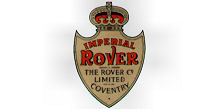




FOR some time we have been aware that the Rover Cycle Co. were busy on a motor bicycle, and, knowing the excellent work that is turned out from the Rover factory, we were not surprised to see a very fine example of motor cycle design and manufacture.
We illustrate this machine herewith, and expect in the course of a few days to give it an extended trial, when we shall be in a better, position to describe its running powers. The illustration of the frame is practically self-descriptive, the method of fastening the engine to the frame being particularly good and workmanlike. The bolts attaching the engine to the frame pass through the cradle plates and T lugs brazed on the end of the frame tubes, the nuts being castellated and fitted with cotter pins, as in motor car practice. The engine, which is 2¼ h.p., is fed by a float feed spray carburetter, the silencer, we are pleased to note, being of lame dimensions, and placed (as is also the exhaust pipe) well out of the way of the carburetter.
The ignition is by trembler coil, which, with two accumulator batteries, are carried in a compartment behind the seat-tube.
The fuel and lubricating tank occupies the whole of the available space of the diamond frame, sufficient petrol being carried for an extended run. The control is by a throttle valve and advance sparking lever, worked off the top tube. These levers have a small serrated quadrant, which keeps them from moving when subjected to vibration.
In addition, there is an exhaust-lifter, operated by a Bowden wire, the lever having a retaining clutch to hold it in any position.
Ample brake power is provided by means of a back-pedalling band brake to the rear wheel, which does not prevent the machine being wheeled backwards; also a rim brake on the front wheel.
We think the Rover Co. have been wise in adopting 26in. wheels, this size having many advantages which cannot be lightly regarded.
In conclusion, the Imperial Rover motor bicycle is one of the smartest turn-outs we have seen, and we cordially wish the Rover Cycle Co. every success with their new pattern.
The Motor Cycle July 8th, 1903.
Rover Cycle Co., Ltd.
This fine exhibit includes a motor cycle and also a forecar, both fitted with 3 h.p. engines carried in a specially-designed and strengthened frame. The engine has two valve shafts, with a separate cam for each valve. On the top of the cylinder is fitted a paraffin valve with snap top, obviating the necessity of unscrewing anything in order to flush the engine out with paraffin. There are many features of interest in the engine itself, such as the attachment of the valve washer to the valve stem, without the use of a cotter. A special form of wipe ignition is fitted, in which the wiping brush is held out of contact with the cam surface, but which is in such a position as to be struck by the cam at each revolution. This obviates any excessive wear of the cam surface or blade.
A very neat form of back-pedalling brake is fitted to the machines on this stand. This brake can be thrown out of action when it is desired to wheel the machine backward, thus overcoming the chief objection to back-pedalling brakes on motor cycles. An ingenious switch and exhaust-lift catch are fitted; in fact, this exhibit is well worthy of the attention of those on the look-out for novelties. Two sets of accumulators and a two-way switch are fitted on all machines. (Stand 149.)
The Motor Cycle, November 25th 1903
Stanley Show 1903
If you have further information or a query related to Rover motorcycles, please contact us